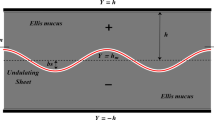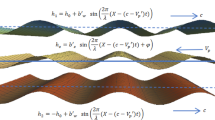Abstract
The purpose of this article is to discuss the motion of five different undulating swimming sheets assisted by an electric field and dynamical interactions. The sine or cosine wavy sheet can be a verge on the spermatozoa's surface. The human cervix is approximated as a rigid two-dimensional channel (with anti-slip effects) under the action of an external electric field. The flow equations of viscus mucus are modeled by using Navier–Stokes equations. The Poisson-Boltzmann equation is employed to simulate the electroosmotic term. Utilizing lubrication and Debye–Huckel approximation, we finally obtained a fourth-order ordinary differential equation with an axial component of velocity as a dependent variable. The closed-form expressions of upper and lower mucus velocity, pressure gradient, and stress components are obtained by utilizing Wolfram Mathematica 13.1. This solution is further used in equilibrium conditions to check whether they are satisfied or not. Off course, conditions will not be satisfied since the guesses are crude. The numerical values of cell speed and flow rate are refined via a root-finding algorithm. These unknowns are further utilized in the formula of work done by the swimmer. The numerical results of cell speed, flow rate, and power delivered are plotted in MATLAB R2022b.












Similar content being viewed by others
Data Availability Statements
Data sharing not applicable to this article as no datasets were generated or analyzed during the current study.
References
D.O. Pushkin, H. Shum, J.M. Yeomans, Fluid transport by individual microswimmers. J. Fluid Mech. 726, 5–25 (2013)
Z. Shen, A. Würger, J.S. Lintuvuori, Hydrodynamic interaction of a self-propelling particle with a wall: comparison between an active Janus particle and a squirmer model. Eur. Phys. J. E 41, 1–9 (2018)
G.I. Taylor, Analysis of the swimming of microscopic organisms. Proc. R. Soc. Lond. Ser. A Math. Phys. Sci. 209(1099), 447–461 (1951)
G.I. Taylor, The action of waving cylindrical tails in propelling microscopic organisms. Proc. R. Soc. Lond. Ser. A Math. Phys. Sci. 211(1105), 225–239 (1952)
B. Chen, Y.D. Liu, S. Chen, S.R. Jiang, H.T. Wu, A biomimetic spermatozoa propulsion method for interventional micro robot. J. Bionic Eng. 5, 106–112 (2008)
A.T. Chwang, T.Y. Wu, A note on the helical movement of micro-organisms. Proc. R. Soc. Lond. Ser. B Biol. Sci. 178(1052), 327–346 (1971)
G.J. Hancock, The self-propulsion of microscopic organisms through liquids. Proc. R. Soc. Lond. Ser. A Math. Phys. Sci. 217(1128), 96–121 (1953)
J. Gray, G.J. Hancock, The propulsion of sea-urchin spermatozoa. J. Exp. Biol. 32(4), 802–814 (1955)
J.E. Drummond, Propulsion by oscillating sheets and tubes in a viscous fluid. J. Fluid Mech. 25(4), 787–793 (1966)
A.J. Reynolds, The swimming of minute organisms. J. Fluid Mech. 23(2), 241–260 (1965)
E.O. Tuck, A note on a swimming problem. J. Fluid Mech. 31(2), 305–308 (1968)
W.J. Shack, T.J. Lardner, A long wavelength solution for a microorganism swimming in a channel. Bull. Math. Biol. 36, 435–444 (1974)
R.E. Smelser, W.J. Shack, T.J. Lardner, The swimming of spermatozoa in an active channel. J. Biomech. 7(4), 349–355 (1974)
D.F. Katz, On the propulsion of micro-organisms near solid boundaries. J. Fluid Mech. 64(1), 33–49 (1974)
J.B. Shukla, B.R.P. Rao, R.S. Parihar, Swimming of spermatozoa in cervix: effects of dynamical interaction and peripheral layer viscosity. J. Biomech. 11(1–2), 15–19 (1978)
J.B. Shukla, P. Chandra, R. Sharma, G. Radhakrishnamacharya, Effects of peristaltic and longitudinal wave motion of the channel wall on movement of micro-organisms: application to spermatozoa transport. J. Biomech. 21(11), 947–954 (1988)
G. Radhakrishnamacharya, R. Sharma, Motion of a self-propelling micro-organism in a channel under peristalsis: effects of viscosity variation. Nonlinear Anal. Modell. Control 12(3), 409–418 (2007)
T.K. Chaudhury, On swimming in a visco-elastic liquid. J. Fluid Mech. 95(1), 189–197 (1979)
L.D. Sturges, Motion induced by a waving plate. J. Non Newton Fluid Mech. 8, 357–364 (1981)
E. Lauga, Propulsion in a viscoelastic fluid. Phys. Fluids 19(8), 083104 (2007)
M. Sajid, N. Ali, A.M. Siddiqui, Z. Abbas, T. Javed, Effects of permeability on swimming of a micro-organism in an Oldroyd-B Fluid. J. Porous Media 17(1), 59–66 (2014)
N. Ali, M. Sajid, Z. Abbas, O.A. Bég, Swimming dynamics of a micro-organism in a couple stress fluid: a rheological model of embryological hydrodynamic propulsion. J. Mech. Med. Biol. 17(03), 1750054 (2017)
P. Sinha, C. Singh, K.R. Prasad, A microcontinuum analysis of the self propulsion of the spermatozoa in the cervical canal. Int. J. Eng. Sci. 20(9), 1037–1048 (1982)
D. Philip, P. Chandra, Self-propulsion of spermatozoa in microcontinua: effect of transverse wave motion of channel walls. Arch. Appl. Mech. 66(1), 90–99 (1995)
Z. Asghar, N. Ali, M. Sajid, Mechanical effects of complex rheological liquid on a microorganism propelling through a rigid cervical canal: swimming at low Reynolds number. J. Braz. Soc. Mech. Sci. Eng. 40(9), 1–16 (2018)
Z. Asghar, N. Ali, M. Sajid, Analytical and numerical study of creeping flow generated by active spermatozoa bounded within a declined passive tract. Eur. Phys. J. Plus 134(1), 1–15 (2019)
Z. Asghar, N. Ali, M. Sajid, O.A. Bég, Magnetic microswimmers propelling through biorheological liquid bounded within an active channel. J. Magn. Magn. Mater. 486, 165283 (2019)
N. Ali, Z. Asghar, M. Sajid, O. Anwar Bég, Biological interactions between Carreau fluid and microswimmers in a complex wavy canal with MHD effects. J. Braz. Soc. Mech. Sci. Eng. 41(10), 1–13 (2019)
Z. Asghar, N. Ali, M. Waqas, M.A. Javed, An implicit finite difference analysis of magnetic swimmers propelling through non-Newtonian liquid in a complex wavy channel. Comput. Math. Appl. 79(8), 2189–2202 (2020)
Z. Asghar, N. Ali, K. Javid, M. Waqas, A.S. Dogonchi, W.A. Khan, Bio-inspired propulsion of micro-swimmers within a passive cervix filled with couple stress mucus. Comput. Methods Programs Biomed. 189, 105313 (2020)
Z. Asghar, N. Ali, M. Waqas, M. Nazeer, W.A. Khan, Locomotion of an efficient biomechanical sperm through viscoelastic medium. Biomech. Model. Mechanobiol. 19, 2271–2284 (2020)
Z. Asghar, N. Ali, K. Javid, M. Waqas, W.A. Khan, Dynamical interaction effects on soft-bodied organisms in a multi-sinusoidal passage. Eur. Phys. J. Plus 136(6), 1–17 (2021)
Z. Asghar, R.A. Shah, W. Shatanawi, N. Ali, A theoretical approach to mathematical modeling of sperm swimming in viscoelastic Ellis fluid in a passive canal. Arch. Appl. Mech. 93(4), 1525–1534 (2022)
Z. Asghar, N. Ali, A mathematical model of the locomotion of bacteria near an inclined solid substrate: effects of different waveforms and rheological properties of couple-stress slime. Can. J. Phys. 97(5), 537–547 (2019)
D. Tripathi, S. Bhushan, O.A. Bég, Analytical study of electro-osmosis modulated capillary peristaltic hemodynamics. J. Mech. Med. Biol. 17(03), 1750052 (2017)
D. Tripathi, A. Yadav, O.A. Bég, R. Kumar, Study of microvascular non-Newtonian blood flow modulated by electroosmosis. Microvasc. Res. 117, 28–36 (2018)
K. Javid, M. Waqas, Z. Asghar, A. Ghaffari, A theoretical analysis of Biorheological fluid flowing through a complex wavy convergent channel under porosity and electro-magneto-hydrodynamics effects. Comput. Methods Programs Biomed. 191, 105413 (2020)
Z. Asghar, M. Waqas, M.A. Gondal, W.A. Khan, Electro-osmotically driven generalized Newtonian blood flow in a divergent micro-channel. Alex. Eng. J. 61(6), 4519–4528 (2022)
R.A. Shah, Z. Asghar, N. Ali, Mathematical modeling related to bacterial gliding mechanism at low Reynolds number with Ellis Slime. Eur. Phys. J. Plus 137(5), 1–12 (2022)
M. Waqas, Z. Asghar, W.A. Khan, Thermo-solutal Robin conditions significance in thermally radiative nanofluid under stratification and magnetohydrodynamics. Eur. Phys. J. Spec. Top. 230(5), 1307–1316 (2021)
M.S. Arif, K. Abodayeh, Y. Nawaz, The modified finite element method for heat and mass transfer of unsteady reacting flow with mixed convection. Front. Phys. 10, 802 (2022)
H. Khan, J. Alzabut, A. Shah, Z. Y. He, S. Etemad, S. Rezapour, A. Zada, On fractal-fractional waterborne disease model: a study on theoretical and numerical aspects of solutions via simulations. Fractals (2023)
H. Khan, J. Alzabut, D. Baleanu, G. Alobaidi, M.U. Rehman, Existence of solutions and a numerical scheme for a generalized hybrid class of n-coupled modified ABC-fractional differential equations with an application. AIMS Math. 8(3), 6609–6625 (2023)
Acknowledgements
Dr. Zeeshan Asghar would like to thank Prince Sultan University for their support through the TAS research laboratory.
Author information
Authors and Affiliations
Corresponding author
Ethics declarations
Conflict of interest
The authors declare that there is no conflict of interests regarding the publication of this article.
Ethical standard
The authors state that this research complies with ethical standards. This research does not involve either human participants or animals.
Rights and permissions
Springer Nature or its licensor (e.g. a society or other partner) holds exclusive rights to this article under a publishing agreement with the author(s) or other rightsholder(s); author self-archiving of the accepted manuscript version of this article is solely governed by the terms of such publishing agreement and applicable law.
About this article
Cite this article
Asghar, Z. Enhancing motility of micro-swimmers via electric and dynamical interaction effects. Eur. Phys. J. Plus 138, 357 (2023). https://doi.org/10.1140/epjp/s13360-023-03963-w
Received:
Accepted:
Published:
DOI: https://doi.org/10.1140/epjp/s13360-023-03963-w




